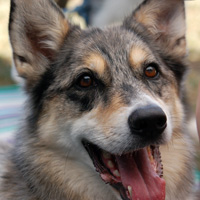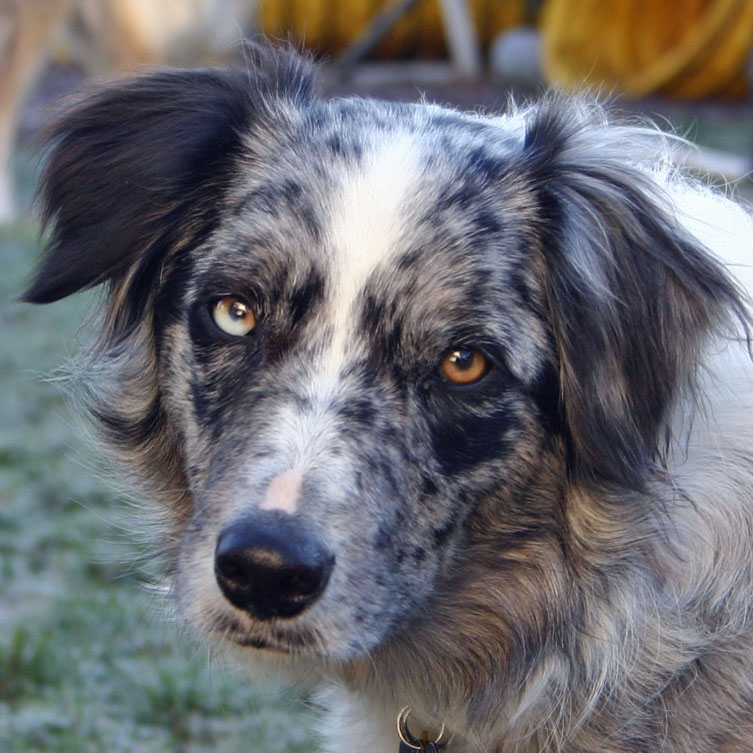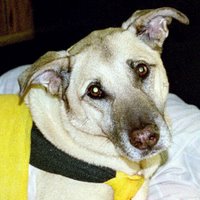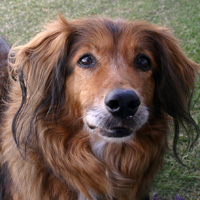Strategic Pairs
SUMMARY: What chaos looks like on a course map.
Of course Strategic Pairs isn't chaotic for a well-tuned, organized team who runs clean. It should be a thing of beauteous communication and stunning agility competence. But--ta-da--not many teams run clean all the way through, hence the chaos.
A course might look like the one shown here. (Ignore the colors; just look at the numbers.) It's designed so that one dog can't run it effectively. On this course, for example, dog A lines up behind the start line for jump #1, while dog B goes out to the far side of the field and lines up for jump #4.
When they're both in position, dog A starts by doing 1-2-3 and then signals somehow (their choice) that they're done, maybe by yelling "Go!". Dog B then does, say, 4-5-6 while dog A is maneuvering to get into position for #7. Dog B signals that they're done, A does 7-8-9, and so on.
This particular course was designed with 3-dog teams in mind, and the colors show how our team opted to do it. (By Susan Rappillus of Western Agility Group for the 2005 Turkey Trot.)
One nice thing is that usually dogs can take out-of-sequence obstacles on their way to get to the next sequence that they intend to do, so it's not too Snookery getting around the course.
Of course, there are myriad options. For example, maybe dog A is lousy at the dogwalk and dog B is lousy at the weaves. So, even though 7-8-9-10 is a little awkward for one dog to do, maybe this team will decide that dog A does that sequence to ensure that the weaves are done correctly the first time.
This "doing it correctly" thing is really important in Strategic Pairs, because IF YOU FAULT AN OBSTACLE, the other dog has to take over and DO THAT OBSTACLE CORRECTLY. Then you can go on from there in any way you want.
So, for example, let's say dog A knocks bar #1. Dog B, who was in the far corner anticipating doing #4, has to run back and take #1 correctly (one or the other of the teammates has to set the bar back up, of course). So maybe dog A yells "Help! #1!" so dog B runs over to do #1-2-3 while dog A runs over to #4 to do the 4-5-6 series.
But remember, dog A has a crappy dogwalk, so they'll probably blow it, so dog B had better be ready to EITHER redo the dogwalk if it's faulted, OR if by some miracle dog A gets the dogwalk, continue on to #7.
You can imagine that emotions run high for both handlers and dogs, and many interesting things have been known to happen on course.
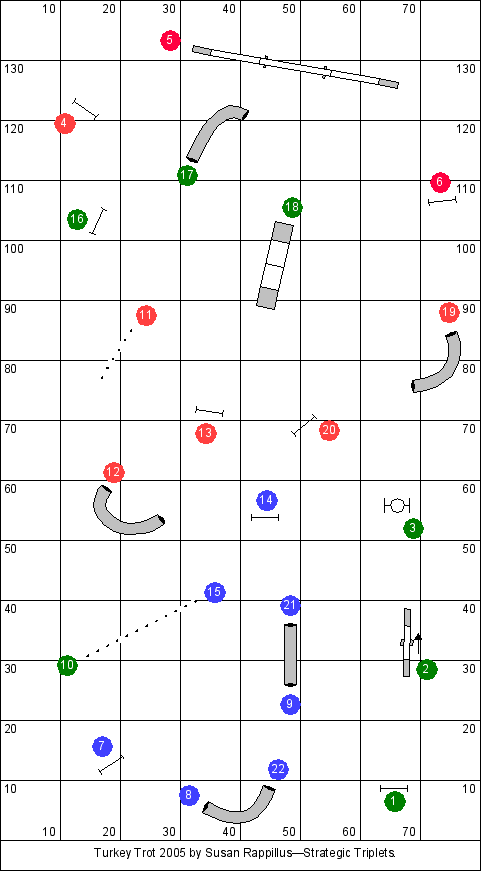
More Info In Response To Questions
Added: Fri, Dec 12, 10 AM PST
In my agility years, I've seen strategic pairs only at Bay Team USDAA trials and this once as a bonus game at this particular CPE trial. It is not an official class in any venue; it's a fun game from back in the days when judges made up fun games so that everyone didn't have to go home after a couple of hours because they ran out of classes and dogs. It's in the same category as Power and Speed or Time Gamble that USDAA had at its Nationals for quite a few years. Just a fun game, some of which stuck in people's minds as wanting to do again but not make into official classes.
Because it's extra, the rules are totally up to the judge (or the club who asked for it, I suppose). Hence, hmm, maybe it's ok if dog B gets loose and follows A on the same obstacles; hmm, maybe there should be a minimum number of obstacles per dog, but would "1" be OK? (Although I've never seen a course where it made sense for either dog to do only 1 obstacle.)
The idea is that the obstacles must, at some point, be taken in order. So if one dog does 1-2-3-9 and the next dog does 4-5-6-12, and the first dog does 2-7-8, that's usually OK because 1-2-3-4-5-6-7-8 have been taken. But it's up to the rule-maker what's legal.
It does make some people's heads explode. Especially if, for example, BOTH dogs KEEP knocking the same *#&@ bar over and over, or missing the same contact over and over... Tika went nuts when I did this course with her--it's the only time I've seen her fly OVER the top of the Aframe.
But the excitement and not having to worry about a Q is usually worth it. You can learn a lot about yourself and your dog in these 60 seconds!
Labels: course maps, extra games
Complete list of labels
